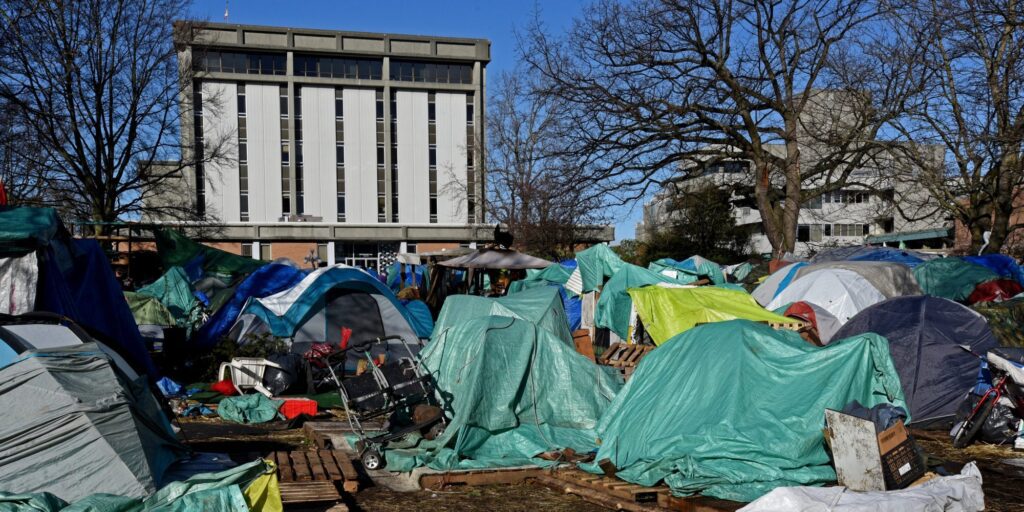Tent Cities Postmortem

[Featured image sourced from Alistair Reign News Blog.]
We’ve had quite a few tent cities here in Victoria in the past decade or so, from the Occupy movement‘s occupation of Centennial Square to those of Topaz Park, Pandora Avenue and Beacon Hill Park. And yet they have achieved very little in the end.
There is much to be reflected upon in retrospect. What could have been done to force governments into enacting lasting change? In a sense, asking the question is denying the answer: while the protesters made themselves heard, they did not have a plan for lasting change, or even a coherent narrative. Their strength was also their weakness: they were loose mobs without leadership or strategy. This is what needs to change in order to bring governments to their knees.
So let’s ponder what should be done next time, if only from a purely tactical standpoint. Let’s learn from the authorities’ playbook and come up with a plan. We draw the line at injuries, although wounding their pride is fair game. Seriously, anything goes as long as nobody gets hurt (much).
The protesters’ most pressing concern should be to build a site which cannot easily be taken down by law enforcement. So far every site was dismantled because the police and bylaw officers were able to use force in the end. How to prevent them from doing so? First of all, it should be set on high grounds. Beacon Hill Park may be the best site for this purpose, as long as the tents are erected on top of the hill, forcing law enforcement to approach uphill.
It should also have a perimeter which keeps the police out. Remember those fences being erected around tenters by the city? These could actually be a boon if they were made very difficult to dismantle, such as with lots of haywire, which is very cheap and easy to come by. See, suddenly the fences are keeping the police out rather than keeping the protesters hemmed in.
So, how to keep the fences from being taken out anyway, if only by towing trucks? Well, the besieged have to defend them, which isn’t all that difficult even with improvised weaponry, from poles with padding on the far end to balloons filled with tar (these all come cheap too), along with a few borrowed fire extinguishers. Tear gas is a problem, but the use of nets above the fences (such as tennis nets) could dramatically reduce exposure to the site.
Of course the besieged could still be overwhelmed by hundreds of cops in riot gear eager to climb over the fences, pressing their weight against that of the defenders, but there are tactics which could make it difficult. One of them is simply to cover the fences in oil (vegetable oil sells by the gallon and is very cheap); just try to climb over them then.
Even better is to keep the invader at bay by blinding them and deafening them. The good old flash-bang would be ideal, but that’s hard to come by. Instead, one could simply improvise magnesium flares (magnesium is one again cheap and easy to come by) and use bear bangers. High-intensity LED flashlights could also be used, along with laser pointers as a deterrent.
If the police stands against the wind, then a smoke screen could also be effective; just burn bags of green leaves doused with gasoline, and voilà! The cops are running for cover because they can’t see or breathe. Need I mention it’s dirt cheap too?
Okay, now you’re asking: what if the police surrounds the site on a sunny day with no wind, wear riot gear and gas masks, and just barge in by the hundred with their eyes shut? What if they bring armoured cars and ram into the fences? What if they fire thousands of rubber bullets while they’re at it? Or worse?
The answer is simple: the protesters win.
Allow me to reiterate that these battles are won in the court of public opinion. If authorities are willing to use graphic levels of brutality to take down the site, it will make enemies of the citizenry, and the ranks of the protesters will swell; the Ferguson protests clearly illustrate this point. Dismantling tent cities would then turn from a seasonal chore to Pyrrhic victories, and the authorities would have to yield in the end.
This is how to win against law enforcement in a contest of force.
Discover more from Rulebreakers
Subscribe to get the latest posts sent to your email.



